 Topics
Topics
 excel
excel
 Excel function learning: several functions you must know for financial reconciliation (share)
Excel function learning: several functions you must know for financial reconciliation (share)
Excel function learning: several functions you must know for financial reconciliation (share)
This article will share with you several functions that are necessary for financial reconciliation. I believe that after reading this tutorial, your data verification work will be many times easier in the future!

Carrying out complicated reconciliation work is often a headache for financial personnel, not only because of the large amount of data, but also during the actual reconciliation process, various problems may arise. All kinds of situations can be said to be reconciliations, but the methods of handling them may be very different. Therefore, today we have sorted out some of the more commonly encountered problems for you. They can all be completed instantly using EXCEL. Let’s do it together. Take a look at the tormenting questions.
1. The simplest reconciliation problem
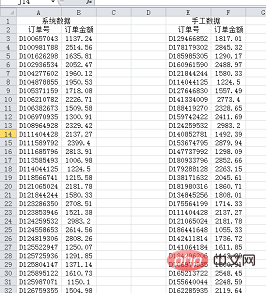
Data description: The left side is the system order data , the right side is manual data (generally provided by suppliers or manually entered and registered by clerks). The system data is complete. Now you need to check which orders are missing manual data.
Use the VLOOKUP function to find the manual data corresponding to the order number. Substitute the formula into the formula according to the format of VLOOKUP (search value, search range, search content, precise search). The search value is the system order number (A3 ), the search range is manual data (E:F), the order number is in the second column of the manual data, and the fourth parameter is 0 when searching accurately, there is a formula: =VLOOKUP(A3,E:F,2 ,0)
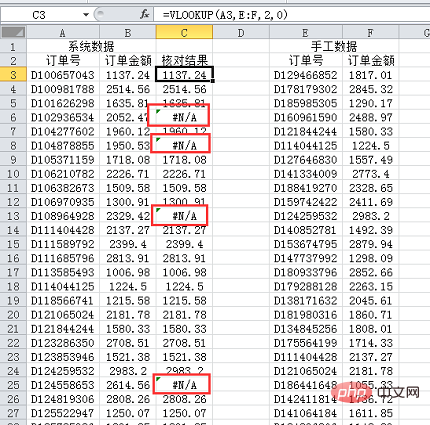
Some #N/A will appear in the data obtained using this formula, indicating that the corresponding data is not found, that is, it exists in the system data. Content that does not exist in manual data needs to be filtered out to find out the reasons.
This is the most commonly used method to check data. Sometimes we not only need to check whether the data exists, but also whether there is a difference in the order amount. At this time, it is inconvenient to use VLOOKUP. You need to use Another function SUMIF.
The idea is to use the SUMIF function to sum the order amount of the manual data according to the system order number, and then subtract it from the system order amount. According to whether the result is 0 and where the difference is, enter the formula in cell D3:
=SUMIF (E:E,A3,F:F)-B3, double-click to fill in the formula, the specific effect is as shown in the figure:
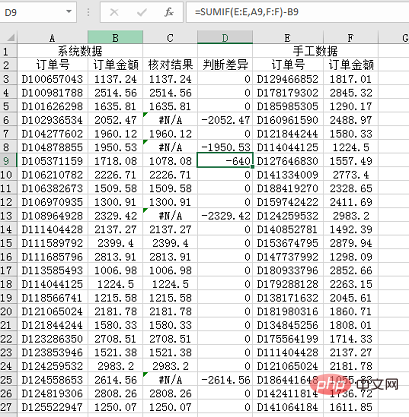
The format of the SUMIF function is: SUMIF (condition area, condition, summation area). In this example, the condition area is the manual order number (column E), the condition is the system order number (A3), and the summation area is the manual order amount. (Column F).
If the difference is 0, it means that the system data matches the manual data. There are two cases of data with a non-zero difference. One is that there is no corresponding manual data, and the other is that the manual data exists but the amount is inconsistent. , this is easy to see when combined with the previous VLOOKUP results.
For example, there is no #N/A error in cell C9 in the picture above, but the value in cell D9 is not zero, indicating that the order data was entered incorrectly.
For more standardized data, it is also very convenient to check. It can usually be solved by using VLOOKUP and SUMIF functions. However, in actual work, you will encounter some less standardized data, so continue to look at it.
2. Slightly troublesome reconciliation issues

On the right side is the system data, only retained There are four columns, which may actually be many columns. Useless columns can be eliminated during verification. On the left is manually registered data, with only three columns.
There is nothing much to say about the system data. Some systems are relatively complete and the exported data is relatively standardized. If we want to find fault with the system data in this example, we can only say that the registration in this expense type is too simple and is basically useless. information.
Looking at the manual data again, the problem is more obvious. There are two problems:
First, the date format is not standardized. Using a decimal point as the year, month, and day separator in the date is probably a lot of decimals. It’s my partner’s habit, but Excel will not treat this format as a date;
Secondly, the date column registration is incomplete, maybe for laziness, there are many empty cells, it is estimated that the empty cells are the same as the above cells The dates in the format are consistent. This is also the entry habit of many friends.
To get such data, you must first process column A. The processing method is: select the data area, press F5 or Ctrl G to open the position, locate the null value and confirm, enter =, and press the direction key ↑ , press the Ctrl key and press Enter to complete the filling; then select the data area, copy and paste it as a value, click Column, directly select the date format in the third step, and you are done. See the animation demonstration for the specific operation.
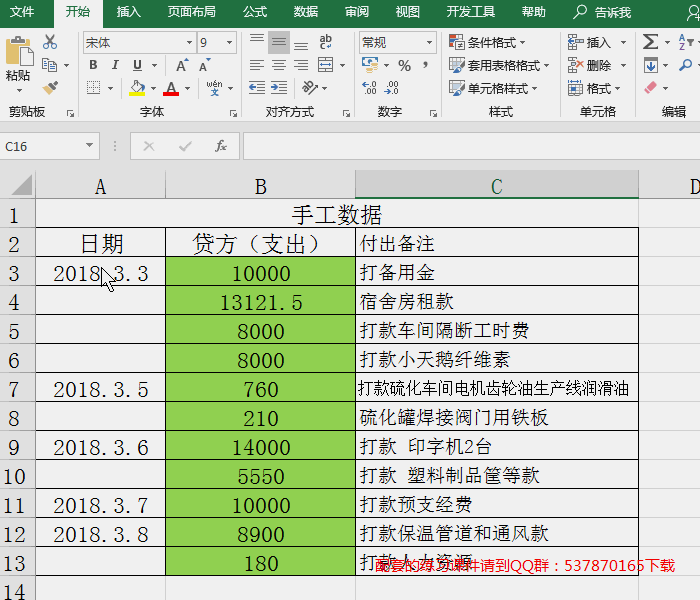
After the data processing is standardized, it is time to check the differences. In this example, it is necessary to determine which data have different amounts on the same date. This includes two conditions: date and amount. Therefore, consider using the SUMIFS function, the basic structure is SUMIFS (sum range, condition range 1, condition 1, condition range 2, condition 2), or use system data as the basis to check manual data. Enter the formula in cell I3 as: = SUMIFS(B:B,A:A,E3,B:B,H3)-H3, double-click to fill.

#If the difference is zero, it means that the data is completely consistent. If it is not zero, you need to filter it out to find the reason for the difference.
Because there is not much data, it can be seen that two transactions of 8,000 appeared on the same date. When we use SUMIFS to sum, the two transactions will be summarized. In fact, there is no real difference. . For such cases where the dates are the same and the amounts are the same but the specific uses are different, it is troublesome to directly use formulas to judge when checking. You can consider using auxiliary columns to make repeated judgments:
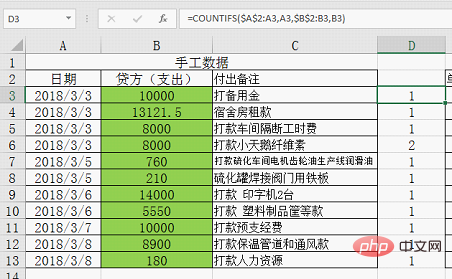
in Use the formula =COUNTIFS($A$2:A3,A3,$B$2:B3,B3) after manual data, which means to count those with the same date and amount. When selecting the range, be sure to check the starting position of the range. Add $ to lock, so that the range of the formula will increase when it is pulled down, and when repeated data appears, the result will also increase.
Similarly, the system data is also processed in this way. The formula is: =COUNTIFS($E$2:E3,E3,$H$2:H3,H3)
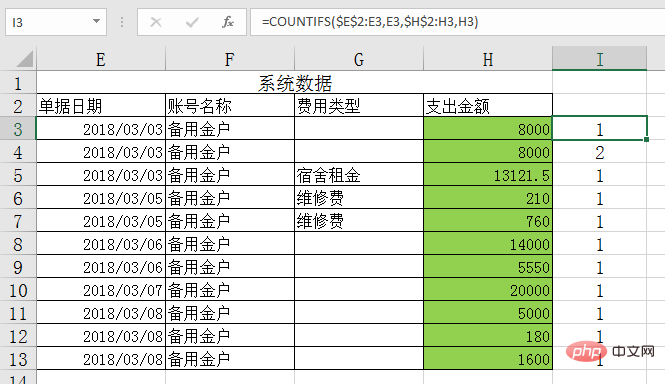
After completing the two auxiliary columns, the formula for checking the amount becomes three conditions:
=SUMIFS(B:B,A:A,E3,B:B ,H3,D:D,I3)-H3, double-click the fill to see the result. A negative number means that the item is not entered in the manual data.
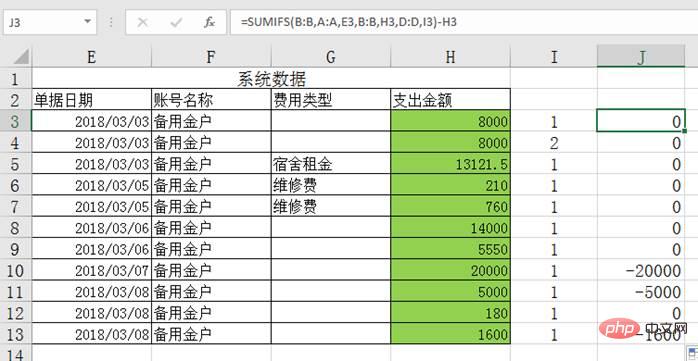
Today I used two examples to analyze common ideas for data verification. When doing more complex verification work, you only need to master VLOOKUP, SUMIF, SUMIFS, COUNTIF and COUNTIFS If you are good at using auxiliary columns among these functions, you can basically find the differences quickly.
Related learning recommendations: excel tutorial
The above is the detailed content of Excel function learning: several functions you must know for financial reconciliation (share). For more information, please follow other related articles on the PHP Chinese website!

Hot AI Tools

Undresser.AI Undress
AI-powered app for creating realistic nude photos

AI Clothes Remover
Online AI tool for removing clothes from photos.

Undress AI Tool
Undress images for free

Clothoff.io
AI clothes remover

Video Face Swap
Swap faces in any video effortlessly with our completely free AI face swap tool!

Hot Article

Hot Tools

Notepad++7.3.1
Easy-to-use and free code editor

SublimeText3 Chinese version
Chinese version, very easy to use

Zend Studio 13.0.1
Powerful PHP integrated development environment

Dreamweaver CS6
Visual web development tools

SublimeText3 Mac version
God-level code editing software (SublimeText3)

Hot Topics
 What should I do if the frame line disappears when printing in Excel?
Mar 21, 2024 am 09:50 AM
What should I do if the frame line disappears when printing in Excel?
Mar 21, 2024 am 09:50 AM
If when opening a file that needs to be printed, we will find that the table frame line has disappeared for some reason in the print preview. When encountering such a situation, we must deal with it in time. If this also appears in your print file If you have questions like this, then join the editor to learn the following course: What should I do if the frame line disappears when printing a table in Excel? 1. Open a file that needs to be printed, as shown in the figure below. 2. Select all required content areas, as shown in the figure below. 3. Right-click the mouse and select the "Format Cells" option, as shown in the figure below. 4. Click the “Border” option at the top of the window, as shown in the figure below. 5. Select the thin solid line pattern in the line style on the left, as shown in the figure below. 6. Select "Outer Border"
 How to filter more than 3 keywords at the same time in excel
Mar 21, 2024 pm 03:16 PM
How to filter more than 3 keywords at the same time in excel
Mar 21, 2024 pm 03:16 PM
Excel is often used to process data in daily office work, and it is often necessary to use the "filter" function. When we choose to perform "filtering" in Excel, we can only filter up to two conditions for the same column. So, do you know how to filter more than 3 keywords at the same time in Excel? Next, let me demonstrate it to you. The first method is to gradually add the conditions to the filter. If you want to filter out three qualifying details at the same time, you first need to filter out one of them step by step. At the beginning, you can first filter out employees with the surname "Wang" based on the conditions. Then click [OK], and then check [Add current selection to filter] in the filter results. The steps are as follows. Similarly, perform filtering separately again
 How to change excel table compatibility mode to normal mode
Mar 20, 2024 pm 08:01 PM
How to change excel table compatibility mode to normal mode
Mar 20, 2024 pm 08:01 PM
In our daily work and study, we copy Excel files from others, open them to add content or re-edit them, and then save them. Sometimes a compatibility check dialog box will appear, which is very troublesome. I don’t know Excel software. , can it be changed to normal mode? So below, the editor will bring you detailed steps to solve this problem, let us learn together. Finally, be sure to remember to save it. 1. Open a worksheet and display an additional compatibility mode in the name of the worksheet, as shown in the figure. 2. In this worksheet, after modifying the content and saving it, the dialog box of the compatibility checker always pops up. It is very troublesome to see this page, as shown in the figure. 3. Click the Office button, click Save As, and then
 How to type subscript in excel
Mar 20, 2024 am 11:31 AM
How to type subscript in excel
Mar 20, 2024 am 11:31 AM
eWe often use Excel to make some data tables and the like. Sometimes when entering parameter values, we need to superscript or subscript a certain number. For example, mathematical formulas are often used. So how do you type the subscript in Excel? ?Let’s take a look at the detailed steps: 1. Superscript method: 1. First, enter a3 (3 is superscript) in Excel. 2. Select the number "3", right-click and select "Format Cells". 3. Click "Superscript" and then "OK". 4. Look, the effect is like this. 2. Subscript method: 1. Similar to the superscript setting method, enter "ln310" (3 is the subscript) in the cell, select the number "3", right-click and select "Format Cells". 2. Check "Subscript" and click "OK"
 How to set superscript in excel
Mar 20, 2024 pm 04:30 PM
How to set superscript in excel
Mar 20, 2024 pm 04:30 PM
When processing data, sometimes we encounter data that contains various symbols such as multiples, temperatures, etc. Do you know how to set superscripts in Excel? When we use Excel to process data, if we do not set superscripts, it will make it more troublesome to enter a lot of our data. Today, the editor will bring you the specific setting method of excel superscript. 1. First, let us open the Microsoft Office Excel document on the desktop and select the text that needs to be modified into superscript, as shown in the figure. 2. Then, right-click and select the "Format Cells" option in the menu that appears after clicking, as shown in the figure. 3. Next, in the “Format Cells” dialog box that pops up automatically
 How to use the iif function in excel
Mar 20, 2024 pm 06:10 PM
How to use the iif function in excel
Mar 20, 2024 pm 06:10 PM
Most users use Excel to process table data. In fact, Excel also has a VBA program. Apart from experts, not many users have used this function. The iif function is often used when writing in VBA. It is actually the same as if The functions of the functions are similar. Let me introduce to you the usage of the iif function. There are iif functions in SQL statements and VBA code in Excel. The iif function is similar to the IF function in the excel worksheet. It performs true and false value judgment and returns different results based on the logically calculated true and false values. IF function usage is (condition, yes, no). IF statement and IIF function in VBA. The former IF statement is a control statement that can execute different statements according to conditions. The latter
 Where to set excel reading mode
Mar 21, 2024 am 08:40 AM
Where to set excel reading mode
Mar 21, 2024 am 08:40 AM
In the study of software, we are accustomed to using excel, not only because it is convenient, but also because it can meet a variety of formats needed in actual work, and excel is very flexible to use, and there is a mode that is convenient for reading. Today I brought For everyone: where to set the excel reading mode. 1. Turn on the computer, then open the Excel application and find the target data. 2. There are two ways to set the reading mode in Excel. The first one: In Excel, there are a large number of convenient processing methods distributed in the Excel layout. In the lower right corner of Excel, there is a shortcut to set the reading mode. Find the pattern of the cross mark and click it to enter the reading mode. There is a small three-dimensional mark on the right side of the cross mark.
 How to insert excel icons into PPT slides
Mar 26, 2024 pm 05:40 PM
How to insert excel icons into PPT slides
Mar 26, 2024 pm 05:40 PM
1. Open the PPT and turn the page to the page where you need to insert the excel icon. Click the Insert tab. 2. Click [Object]. 3. The following dialog box will pop up. 4. Click [Create from file] and click [Browse]. 5. Select the excel table to be inserted. 6. Click OK and the following page will pop up. 7. Check [Show as icon]. 8. Click OK.





